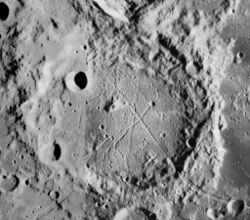Astronomy:Hevelius (crater)
 Mosaic of Lunar Orbiter 4 images | |
| Diameter | 106 km |
|---|---|
| Depth | 1.8 km |
| Colongitude | 68° at sunrise |

Hevelius is a low-rimmed lunar impact crater that lies at the western edge of the Oceanus Procellarum, named after the astronomer Johannes Hevelius by the IAU in 1935.[1] The smaller but prominent crater Cavalerius is joined to the northern rim by low ridges. Due south of Hevelius is the crater Lohrmann and the dark-hued Grimaldi.
The crater's name was approved by the IAU in 1970.[2]
Only a low, eroded rim of Hevelius rises above the surface. The western wall is overlain by several small impacts. The flat floor of the crater has been flooded by lava, and is now cross-crossed by a system of small clefts named the Rimae Hevelius. There is a low, one-km-high central peak offset to the northwest of the midpoint. The northeastern part of the interior is more irregular and contains a straight ridge running toward the southeast. Along the northwest floor, near the inner wall, is a small crater.
Hevelius is a crater of Nectarian age.[3]
This feature is sometimes referred to as Hevel, the astronomer's name in German (Hevelius is a Latinized form).
Satellite craters

By convention these features are identified on lunar maps by placing the letter on the side of the crater midpoint that is closest to Hevelius.
| Hevelius | Latitude | Longitude | Diameter |
|---|---|---|---|
| A | 2.9° N | 68.1° W | 14 km |
| B | 1.4° N | 68.8° W | 14 km |
| D | 3.1° N | 60.8° W | 8 km |
| E | 2.9° N | 65.7° W | 9 km |
| J | 0.7° N | 69.7° W | 14 km |
| K | 1.5° N | 70.0° W | 6 km |
| L | 2.0° N | 70.3° W | 7 km |
References
- ↑ Hevelius, Gazetteer of Planetary Nomenclature, International Astronomical Union (IAU) Working Group for Planetary System Nomenclature (WGPSN)
- ↑ Kibalʹchich, Gazetteer of Planetary Nomenclature, International Astronomical Union (IAU) Working Group for Planetary System Nomenclature (WGPSN)
- ↑ The geologic history of the Moon. USGS Professional Paper 1348. By Don E. Wilhelms, John F. McCauley, and Newell J. Trask. U.S. Government Printing Office, Washington: 1987. Table 9-4.
- Andersson, L. E.; Whitaker, E. A. (1982). NASA Catalogue of Lunar Nomenclature. NASA RP-1097.
- Blue, Jennifer (July 25, 2007). "Gazetteer of Planetary Nomenclature". USGS. http://planetarynames.wr.usgs.gov/.
- Bussey, B.; Spudis, P. (2004). The Clementine Atlas of the Moon. New York: Cambridge University Press. ISBN 978-0-521-81528-4.
- Cocks, Elijah E.; Cocks, Josiah C. (1995). Who's Who on the Moon: A Biographical Dictionary of Lunar Nomenclature. Tudor Publishers. ISBN 978-0-936389-27-1. https://archive.org/details/isbn_9780936389271.
- McDowell, Jonathan (July 15, 2007). "Lunar Nomenclature". Jonathan's Space Report. http://host.planet4589.org/astro/lunar/.
- Menzel, D. H.; Minnaert, M.; Levin, B.; Dollfus, A.; Bell, B. (1971). "Report on Lunar Nomenclature by the Working Group of Commission 17 of the IAU". Space Science Reviews 12 (2): 136–186. doi:10.1007/BF00171763. Bibcode: 1971SSRv...12..136M.
- Moore, Patrick (2001). On the Moon. Sterling Publishing Co.. ISBN 978-0-304-35469-6. https://archive.org/details/patrickmooreonmo00patr.
- Price, Fred W. (1988). The Moon Observer's Handbook. Cambridge University Press. ISBN 978-0-521-33500-3.
- Rükl, Antonín (1990). Atlas of the Moon. Kalmbach Books. ISBN 978-0-913135-17-4.
- Webb, Rev. T. W. (1962). Celestial Objects for Common Telescopes (6th revised ed.). Dover. ISBN 978-0-486-20917-3. https://archive.org/details/celestialobjects00webb.
- Whitaker, Ewen A. (1999). Mapping and Naming the Moon. Cambridge University Press. ISBN 978-0-521-62248-6.
- Wlasuk, Peter T. (2000). Observing the Moon. Springer. ISBN 978-1-85233-193-1.
 |


